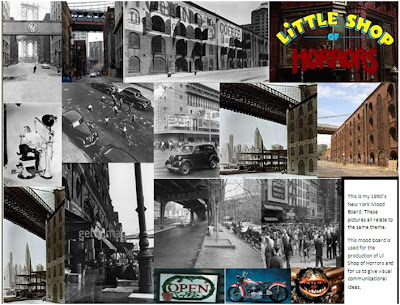For the production ‘Little shop of Horrors’ I got involved in with different things. Before the show I helped out to make the plant – this included sketching, wiring everything together, and painting. On the actual day of the production, I helped put the plant on stage. We made miniature scales for the set so we could see what it looks like in big size, and then helped paint everything. I lent a hand in making the tools of the dentist chair, and the flowers for the set. We used different coloured tissue paper and scrunched it up to make it look like a flower. This is all included as prop construction. As I made most of the props and helped construct and what everyone else in the group should do. This helped with my organisational skills.
I helped with selling leaflets at the front door. We sold them for 30p; this helped with my selling skills and communication with the audience. I had also helped out backstage doing the curtains – opening and closing them. I also helped with the Graphic design of the poster. We decided to use black and red colours to make it seem that the show will be adventurous and dangerous. As the colour red shows blood and jeopardy. We put all the details at the bottom of the poster e.g. venue, time, date etc. We’d also included a big image of the plant on the front as it’s the most important thing about the show. With some help I also made the ‘Mushnik Florist’ sign to go on stage, as well as the set painting. I didn’t want to make it to big otherwise it would take up the whole stage and not to small otherwise the audience at the back wouldn’t be able to see. I got involved with stage management this included in helping getting the guy in an out of the plant the technical requirements of the show such as the model box and the plant. I also got involved with the Visual research this incorporated with the 1950’s mood board, and mind map. This helped me gain more knowledge on my research skills as I had to explore different words and images related to 1950’s New York. I had to also be aware of the Copyright issue. As you can see in my other file, after all of these things that I got involved with I had to make sure of the Health and Safety Precautions for the production – before, during and after.
One element of the project that I consider that I’ve learnt from the most is when I was working back stage with the actors/ actresses, client, and the whole team production. I feel that any difficulty that arises I overcame and handled without delay as you have to be prepared to face anything that may cause the show not to run efficiently. You can prevent things like this from happening by rehearsing as much as you can, keep checking lists that need to be done, make sure everyone is available when needed and that everything works constructively well. Having an organisational manger is very important and can make a huge improvement in comparison to not having one at all.
I’ve also learnt that while creating the props and action prop construction we needed to be precise of the measurements. Rehearsing is fundamental as you can improve for the live show and make any arrangements such as when its queue to open and close curtains, the different lighting (brightness, colour, position etc) sound, and the use of props (position and the placements of the background.
What I found out from pre production work is that Pre-production is the process of preparing all the elements involved in a film, play, or other performance’s. We worked hard when the show was coming close to the deadline by researching more information and having a timescale. If we work with pressure during his time then I feel it’s important in planning a performance because the show can go on smoothly and you know what to expect. To be more successful in finishing all tasks given it will be good to have an classify and arrange a management leader who will give up their free time to help instruct and teach all the team members with tasks bearing in mind the time scale. If we have a strict timeline there will be dis-advantages like everyone will have to work quickly while achieving high standard work, but most of all its good because the work will be done. During pre-production, the script is broken down into individual scenes and all the locations, props, cast members, costumes, special effects and visual effects are identified.
I believe that I was good at showing my artistic skills when I got involved in the graphic designs of the poster, the drawing of the “Mushnik Florist” sign on stage, and also making miniature scales for the set, and when I helped paint everything. Also I felt I was good at the finding of the images. This was useful for me as well because it assisted me with my researching visually skills by using search engines.
I feel that I was bad at meeting the deadlines straight away after the work was given even though I did get it done. I’m also a perfectionist, so I want everything to be complete up to standard and I have high expectations in my own work, and I want to do well and I tried very hard in the whole production.





























